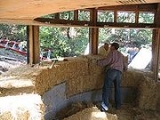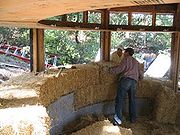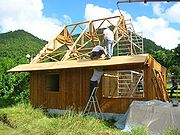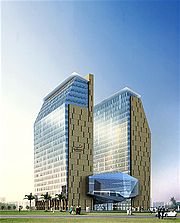
Alternative natural materials
Encyclopedia
Alternative natural materials is a general term that describes natural materials like rock
or adobe
that are not as commonly in use as materials such as wood
or iron
. Alternative natural materials have many practical uses in areas such as sustainable architecture
and engineering
. The main purpose of using such materials is to minimize the negative effects that our built environment can have on the planet while increasing the efficiency and adaptability of the structures.
as a fireproof construction method for building farmhouses. Another more common example is adobe. Adobe homes are prominent in the southwestern U.S. and several Spanish-speaking countries.
Straw bale construction is a more modern concept, but there even exists evidence that straw was used to make homes in African prairies as far back as the Paleolithic
times.
Alternative natural materials, specifically their applications, have only recently made their way into more common use. The ideas of being both green and sustainable in response to global warming
and climate change
shifted more of a focus onto the materials and methods used to build our cityscape
and homes. As environmentally conscious decisions became commonplace, the use of alternative natural materials instead of typical natural materials or man-made materials that rely heavily on natural resources became prominent.
and thermal insulation
. These characteristics make stone a great idea because the temperature in the house stays rather constant thus requiring less air conditioning and other cooling systems. Types of rocks that can be employed are reject stone (pieces of stone that are not able to be used for another task), limestone
, and flagstone
.

. Straw provides excellent insulation and fire resistance in a traditional post-and-beam structure, where a wood frame supports the house. These straw walls are about 75% more energy efficient than standard drywalls and because no oxygen can get through the walls, fire cannot spread and there is no chance of combustion
.

is being used for structures like bridges and homes. Bamboo is surprisingly strong and rather flexible and grows incredibly fast, making it a rather abundant material. Although it can be difficult to join corners together, bamboo is immensely strong and makes up for the hardships that can be encountered while building it.
and other lumber
that usually go to waste. These small blocks of wood can easily be put together to make a structure that, like stone, has great insulation as well as thermal mass. Cordwood provides the rustic look of log cabins without the use of tons of lumber. You can build an entire building with just cordwood or use stones to fill in the walls.
is a very abundant material that can be used in place of concrete
and brick
. Soil
is packed tightly into wall molds where it is rammed together and hardened to form a durable wall packing made of nothing more than dirt, stones, and sticks. Rammed Earth also provides great thermal mass, which means great energy savings. In addition, it is very weatherproof and durable enough that it was used in the Great Wall of China.
is a unique building technique in which buildings are completely constructed on at least one side by some form of Earth whether it be a grass roof, clay walls, or both. This unique system usually includes plenty of windows because of the difficulty involved with using too much electricity in such a house. This adds to the energy efficiency
of the house by reducing lighting costs.
is an interesting and very new material that is a good substitute for concrete. Papercrete is shredded paper, sand, and cement mixed together that forms a very durable brick-like material. Buildings utilizing papercrete are very well-insulated as well as being termite- and fire-resistant. Papercrete is very cheap as it usually only costs about $0.35 per square foot.
is an age-old technique that is cheap, easy to obtain, and ideal for hot environments. A mixture of sand
, clay
, and water is poured into a mold and left in the sun to dry. When dried, it is exceptionally strong and heat-resistant. Adobe doesn’t let much heat through to the inside of the structure, thus providing excellent insulation during the summer to reduce energy costs. Although this clay mixture provides excellent insulation from heat, it is not very waterproof and can be dangerous in earth-quake prone areas due to its tendency to crack easily.
is a good material to combine with clay or cement mixtures and use for walls. These walls turn out surprisingly sturdy and effectively recycle any trees that may need to be excavated from the building area. Depending what type of sawdust used (hardwood
is best) the wood chips in the walls absorb moisture and help prevent cracking during freeze/thaw cycles. Sawdust may be combined with water and frozen to produce a material commonly known as pykrete
, which is strong, and less prone to melting than regular ice.
 Although this a newer technology there are some buildings that have already employed these materials, as well as other tactics, to make themselves green.
Although this a newer technology there are some buildings that have already employed these materials, as well as other tactics, to make themselves green.
Rock (geology)
In geology, rock or stone is a naturally occurring solid aggregate of minerals and/or mineraloids.The Earth's outer solid layer, the lithosphere, is made of rock. In general rocks are of three types, namely, igneous, sedimentary, and metamorphic...
or adobe
Adobe
Adobe is a natural building material made from sand, clay, water, and some kind of fibrous or organic material , which the builders shape into bricks using frames and dry in the sun. Adobe buildings are similar to cob and mudbrick buildings. Adobe structures are extremely durable, and account for...
that are not as commonly in use as materials such as wood
Wood
Wood is a hard, fibrous tissue found in many trees. It has been used for hundreds of thousands of years for both fuel and as a construction material. It is an organic material, a natural composite of cellulose fibers embedded in a matrix of lignin which resists compression...
or iron
Iron
Iron is a chemical element with the symbol Fe and atomic number 26. It is a metal in the first transition series. It is the most common element forming the planet Earth as a whole, forming much of Earth's outer and inner core. It is the fourth most common element in the Earth's crust...
. Alternative natural materials have many practical uses in areas such as sustainable architecture
Sustainable architecture
Sustainable architecture is a general term that describes environmentally conscious design techniques in the field of architecture. Sustainable architecture is framed by the larger discussion of sustainability and the pressing economic and political issues of our world...
and engineering
Engineering
Engineering is the discipline, art, skill and profession of acquiring and applying scientific, mathematical, economic, social, and practical knowledge, in order to design and build structures, machines, devices, systems, materials and processes that safely realize improvements to the lives of...
. The main purpose of using such materials is to minimize the negative effects that our built environment can have on the planet while increasing the efficiency and adaptability of the structures.
History
Alternative natural materials have existed for quite some time but often in very basic forms or only as ingredients to a particular material in the past. For example, earth used as a building material for walls of houses has existed for thousands of years. Much more recently, in the 1920’s, the United States government promoted rammed earthRammed earth
Rammed earth, also known as taipa , tapial , and pisé , is a technique for building walls using the raw materials of earth, chalk, lime and gravel. It is an ancient building method that has seen a revival in recent years as people seek more sustainable building materials and natural building methods...
as a fireproof construction method for building farmhouses. Another more common example is adobe. Adobe homes are prominent in the southwestern U.S. and several Spanish-speaking countries.
Straw bale construction is a more modern concept, but there even exists evidence that straw was used to make homes in African prairies as far back as the Paleolithic
Paleolithic
The Paleolithic Age, Era or Period, is a prehistoric period of human history distinguished by the development of the most primitive stone tools discovered , and covers roughly 99% of human technological prehistory...
times.
Alternative natural materials, specifically their applications, have only recently made their way into more common use. The ideas of being both green and sustainable in response to global warming
Global warming
Global warming refers to the rising average temperature of Earth's atmosphere and oceans and its projected continuation. In the last 100 years, Earth's average surface temperature increased by about with about two thirds of the increase occurring over just the last three decades...
and climate change
Climate change
Climate change is a significant and lasting change in the statistical distribution of weather patterns over periods ranging from decades to millions of years. It may be a change in average weather conditions or the distribution of events around that average...
shifted more of a focus onto the materials and methods used to build our cityscape
Cityscape
A cityscape is the urban equivalent of a landscape. Townscape is roughly synonymous with cityscape, though it implies the same difference in urban size and density implicit in the difference between the words city and town. In urban design the terms refer to the configuration of built forms and...
and homes. As environmentally conscious decisions became commonplace, the use of alternative natural materials instead of typical natural materials or man-made materials that rely heavily on natural resources became prominent.
Rock
Rock is a great way to get away from traditional materials that are harmful to the environment. Rocks have two great characteristics: good thermal massThermal mass
Thermal mass is a concept in building design which describes how the mass of the building provides "inertia" against temperature fluctuations, sometimes known as the thermal flywheel effect...
and thermal insulation
Thermal insulation
Thermal insulation is the reduction of the effects of the various processes of heat transfer between objects in thermal contact or in range of radiative influence. Heat transfer is the transfer of thermal energy between objects of differing temperature...
. These characteristics make stone a great idea because the temperature in the house stays rather constant thus requiring less air conditioning and other cooling systems. Types of rocks that can be employed are reject stone (pieces of stone that are not able to be used for another task), limestone
Limestone
Limestone is a sedimentary rock composed largely of the minerals calcite and aragonite, which are different crystal forms of calcium carbonate . Many limestones are composed from skeletal fragments of marine organisms such as coral or foraminifera....
, and flagstone
Flagstone
Flagstone, is a generic flat stone, usually used for paving slabs or walkways, patios, fences and roofing. It may be used for memorials, headstones, facades and other constructions. The name derives from Middle English flagge meaning turf, perhaps from Old Norse flaga meaning slab.Flagstone is a...
.

Straw
Straw bales can be used as a basis for walls instead of drywallDrywall
Drywall, also known as plasterboard, wallboard or gypsum board is a panel made of gypsum plaster pressed between two thick sheets of paper...
. Straw provides excellent insulation and fire resistance in a traditional post-and-beam structure, where a wood frame supports the house. These straw walls are about 75% more energy efficient than standard drywalls and because no oxygen can get through the walls, fire cannot spread and there is no chance of combustion
Combustion
Combustion or burning is the sequence of exothermic chemical reactions between a fuel and an oxidant accompanied by the production of heat and conversion of chemical species. The release of heat can result in the production of light in the form of either glowing or a flame...
.

Bamboo
In Asian countries, bambooBamboo
Bamboo is a group of perennial evergreens in the true grass family Poaceae, subfamily Bambusoideae, tribe Bambuseae. Giant bamboos are the largest members of the grass family....
is being used for structures like bridges and homes. Bamboo is surprisingly strong and rather flexible and grows incredibly fast, making it a rather abundant material. Although it can be difficult to join corners together, bamboo is immensely strong and makes up for the hardships that can be encountered while building it.
Cordwood
Cordwood is a combination of small remnants of firewoodFirewood
Firewood is any wood-like material that is gathered and used for fuel. Generally, firewood is not highly processed and is in some sort of recognizable log or branch form....
and other lumber
Lumber
Lumber or timber is wood in any of its stages from felling through readiness for use as structural material for construction, or wood pulp for paper production....
that usually go to waste. These small blocks of wood can easily be put together to make a structure that, like stone, has great insulation as well as thermal mass. Cordwood provides the rustic look of log cabins without the use of tons of lumber. You can build an entire building with just cordwood or use stones to fill in the walls.
Rammed Earth
Rammed EarthRammed earth
Rammed earth, also known as taipa , tapial , and pisé , is a technique for building walls using the raw materials of earth, chalk, lime and gravel. It is an ancient building method that has seen a revival in recent years as people seek more sustainable building materials and natural building methods...
is a very abundant material that can be used in place of concrete
Concrete
Concrete is a composite construction material, composed of cement and other cementitious materials such as fly ash and slag cement, aggregate , water and chemical admixtures.The word concrete comes from the Latin word...
and brick
Brick
A brick is a block of ceramic material used in masonry construction, usually laid using various kinds of mortar. It has been regarded as one of the longest lasting and strongest building materials used throughout history.-History:...
. Soil
Soil
Soil is a natural body consisting of layers of mineral constituents of variable thicknesses, which differ from the parent materials in their morphological, physical, chemical, and mineralogical characteristics...
is packed tightly into wall molds where it is rammed together and hardened to form a durable wall packing made of nothing more than dirt, stones, and sticks. Rammed Earth also provides great thermal mass, which means great energy savings. In addition, it is very weatherproof and durable enough that it was used in the Great Wall of China.
Earth-Sheltered
Earth shelteringEarth sheltering
Earth sheltering is the architectural practice of using earth against building walls for external thermal mass, to reduce heat loss, and to easily maintain a steady indoor air temperature...
is a unique building technique in which buildings are completely constructed on at least one side by some form of Earth whether it be a grass roof, clay walls, or both. This unique system usually includes plenty of windows because of the difficulty involved with using too much electricity in such a house. This adds to the energy efficiency
Efficient energy use
Efficient energy use, sometimes simply called energy efficiency, is the goal of efforts to reduce the amount of energy required to provide products and services. For example, insulating a home allows a building to use less heating and cooling energy to achieve and maintain a comfortable temperature...
of the house by reducing lighting costs.
Papercrete
PapercretePapercrete
Papercrete is a recently developed construction material which consists of re-pulped paper fiber with Portland cement or clay and/or other soil added. First patented in 1928, it has been revived since the 1980s. Although perceived as an environmentally friendly material due to the significant...
is an interesting and very new material that is a good substitute for concrete. Papercrete is shredded paper, sand, and cement mixed together that forms a very durable brick-like material. Buildings utilizing papercrete are very well-insulated as well as being termite- and fire-resistant. Papercrete is very cheap as it usually only costs about $0.35 per square foot.
Adobe
AdobeAdobe
Adobe is a natural building material made from sand, clay, water, and some kind of fibrous or organic material , which the builders shape into bricks using frames and dry in the sun. Adobe buildings are similar to cob and mudbrick buildings. Adobe structures are extremely durable, and account for...
is an age-old technique that is cheap, easy to obtain, and ideal for hot environments. A mixture of sand
Sand
Sand is a naturally occurring granular material composed of finely divided rock and mineral particles.The composition of sand is highly variable, depending on the local rock sources and conditions, but the most common constituent of sand in inland continental settings and non-tropical coastal...
, clay
Clay
Clay is a general term including many combinations of one or more clay minerals with traces of metal oxides and organic matter. Geologic clay deposits are mostly composed of phyllosilicate minerals containing variable amounts of water trapped in the mineral structure.- Formation :Clay minerals...
, and water is poured into a mold and left in the sun to dry. When dried, it is exceptionally strong and heat-resistant. Adobe doesn’t let much heat through to the inside of the structure, thus providing excellent insulation during the summer to reduce energy costs. Although this clay mixture provides excellent insulation from heat, it is not very waterproof and can be dangerous in earth-quake prone areas due to its tendency to crack easily.
Sawdust
SawdustSawdust
Sawdust is a by-product of cutting lumber with a saw, composed of fine particles of wood. It can present a hazard in manufacturing industries, especially in terms of its flammability....
is a good material to combine with clay or cement mixtures and use for walls. These walls turn out surprisingly sturdy and effectively recycle any trees that may need to be excavated from the building area. Depending what type of sawdust used (hardwood
Hardwood
Hardwood is wood from angiosperm trees . It may also be used for those trees themselves: these are usually broad-leaved; in temperate and boreal latitudes they are mostly deciduous, but in tropics and subtropics mostly evergreen.Hardwood contrasts with softwood...
is best) the wood chips in the walls absorb moisture and help prevent cracking during freeze/thaw cycles. Sawdust may be combined with water and frozen to produce a material commonly known as pykrete
Pykrete
Pykrete is a composite material made of approximately 14 percent sawdust or some other form of wood pulp and 86 percent ice by weight. Its use was proposed during World War II by Geoffrey Pyke to the British Royal Navy as a candidate material for making a huge, unsinkable aircraft carrier...
, which is strong, and less prone to melting than regular ice.
Examples

- One such building is the Dubiotech headquarters in Dubai in the United Arab Emirates. This building is covered in solar panels and windows, which lets plenty of natural light in while also getting maximum use out of the sunlight. This building (planned for completion this year) will also be built with an alternative kind of steel that is not made by a process that releases tons of harsh chemicals into the atmosphere.
- Another example is the School of Art, Media, and Design located in Singapore. This school has a roof made completely of grass (an example of Earth-sheltering). This allows the use of less concrete and other materials for the roof, and the building also includes lots of window to utilize natural lighting.
See also
- Natural Materials
- Green BuildingGreen buildingGreen building refers to a structure and using process that is environmentally responsible and resource-efficient throughout a building's life-cycle: from siting to design, construction, operation, maintenance, renovation, and demolition...
- Sustainable architectureSustainable architectureSustainable architecture is a general term that describes environmentally conscious design techniques in the field of architecture. Sustainable architecture is framed by the larger discussion of sustainability and the pressing economic and political issues of our world...
- Sustainable landscapingSustainable landscapingSustainable landscaping encompasses a variety of practices that have developed in response to environmental issues. These practices are used in every phase of landscaping, including design, construction, implementation and management of residential and commercial landscapes. Issues of...
- Sustainable landscape architectureSustainable landscape architectureSustainable landscape architecture is a category of sustainable design concerned with the planning and design of outdoor space.This can include ecological, social and economic aspects of sustainability...
- Sustainable gardeningSustainable gardeningSustainable gardening comprises a disparate group of horticultural interests that share, to a greater or lesser extent, the aims and objectives associated with the international post-1980s sustainable development and sustainability programs...

